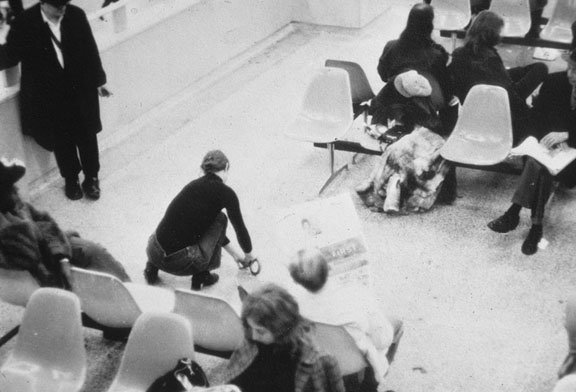PERFORMANCE AND FILM
Red Tape
Bronxville to NY
DRAWINGS
Scheme to Annihilate Magnificent distances
SCULPTURES / INSTALLATIONS / EARTHWORKS
For Fools and Madmen
No Man’ s Land
Hellgate Maze
Ceremonial Conjecture
Gulliver’ s Blocks
Models
Other Sculpture/Installations
LINE
“The transference of line to a free environment produces a number of extremely important results. Its outer expediency turns into an inner one…and as a result, line discloses an inner sound of artistic significance.” Kandinsky. This quote describes the artist’ s site sculptures, installations or environments that free line into three-dimensional space and animate the work by inviting audiences to move through it.
Of her first installation, For Fools and Madmen, Susan Heinemann wrote in Artforum, May 1975, “ It is the viewer who is the performer.” This room- sized maze was built in a Soho gallery with two-by-fours, hardware cloth and barbed wire, and through its materiality was meant to articulate the constraints of society as well as to make reference to the myth of Theseus and Ariadne. During the exhibition, the artist sat knitting in the back of the darkened room, her ball of yarn getting smaller inside the maze, and the sound of a metronome marking the minutes made the sense of time more profound.
No Mans Land, 1973, was built by art students at Kutztown State College, Kutztown, New Jersey. Using barbed wire and wooden posts, this work was a commentary on institutional constraints. After the work was complete, in an ironic mimetic, the university surrounded the work with police tape.
Hellgate Maze on Wards Island, NY, 1980-1981, was a mystical passageway that viewers were invited to enter. The imagery of the work, taken from ancient Scandinavian coastal sites, described the tumultuous meeting of two rivers where many ships perished. The opening event was anointed by a small parade of Charlie Morrow’ s Ocarina Players.
Ceremonial Conjecture (1981-82), an earthwork built in a meadow at The Morris Museum in Morristown, NJ, accessed spiritual and ancient ceremonial structures. Of this work, Marion Filler wrote “ Thea and Kaplan (collaborators) have designed a shallow serpentine trench that winds through the field behind the museum evocative of Indian motifs. The earth that was removed from the trenches has been used to construct two groups of mounds that are an integral part of the design. At the end of the project, which will remain on the grounds for six months, the land will be refilled with the same earth that has been displaced and the area will return to its previous condition...The change of seasons should create interesting variations in the mood of the piece. At present, the trenches are dark brown accents against a field of green. When the snow comes they will be carved in relief against a background of white. The piece also works on ground level where it is a participatory event.”
Daphne at Bard College 1984, was a proposal for the project “ Land Marks // New site proposals by twenty-two original pioneers of environmental art.” The catalog read: “ While running from Apollo, a la Muybridge, Daphne traces a line around a 2000 foot ravine at Bard College.
The ambient landscape serves as the background tableau against which this work choreographically narrates the story of the mythic Daphne, who, in an effort to elude Apollo, flees deeper and deeper into the woods, to be eventually turned into a tree. The myth itself can be read metaphorically as a gloss on the dichotomy between nature and culture. The positions catch Daphne in the course of her escape and transformation as she in bodily metamorphosed and spiritually converted from mortal to wood nymph –a process symbolized by the tree, her bush soul” .
In Gulliver’ s Blocks, for “ Sculpture, 1980” and the Maryland Institute of Art, Baltimore, MD, the artist filmed one cube rolling down Federal Hill and from the fall line, she selected three film frames to establish their final positioning. The work implies collapsing systems.
Thea’ s LINE has permutations in performance, film, and drawings. In each of these categories, the artist flirts with the most basic activity associated with art making. Just as the drawn line is in a constant state of evolution, the artist moves off the paper through space and time to represent a state of transformation.
In her performance piece Red Tape, in the New York City Port Authority bus station, 1973, the artist draws herself (with red tape) into a linear square and proceeds to wrap herself in the tape. The activity is a metaphor for the political/institutional constraints on the individual. Before the end of the performance, the police requested she halt her activity.
Her super 8 film, Bronxville to New York City, 1974, captures the linear landscape through the window of a moving train. The film makes visible the indifference or blindness that occurs through repeated commutes. It captures the changing landscape from the suburb to the city.
Scheme to Annihilate Magnificent Distances, 1974, again uses the commuter train motif. Here the artist traces train routes borrowed from a Hagstrom map. She incorporates language through punning, mirroring and mark making. Her informal snapshots of train stations now demolished or renovated inadvertently captured time.
Through mediation and meditation, the drawings, High Speed Memory, 1977, the artist takes as inspiration (for the line making) the minimal tonal variations in Philip Glass’ s music – and her palette references memories of her mother’ s bedroom.
Her solo installation at the Queens Museum, Journal, 1989, features monochrome ultramarine paintings and sculptures. Pinned to the wall, they form a grid from June to January. The culmination of drawings won her a NEA in 1990.










